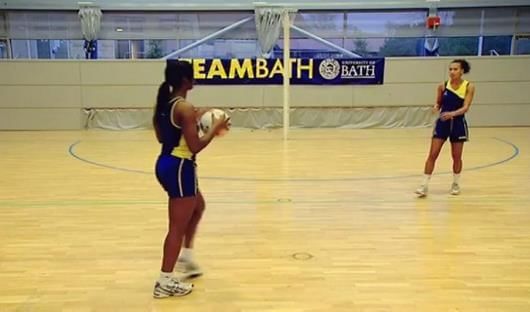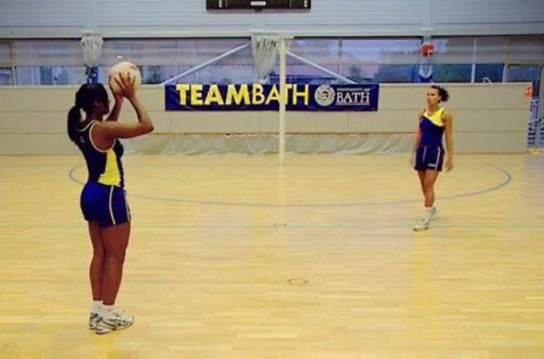Year 6 Exam > Year 6 Notes > Physical Education for Year 6 > Essential Skills and Techniques: Netball
Essential Skills and Techniques: Netball | Physical Education for Year 6 PDF Download
| Table of contents |

|
| Netball Standing Shot |

|
| Performing a Bounce Pass in Netball |

|
| Performing a Chest Pass in Netball |

|
| Pivoting in Netball |

|
| Performing a Shoulder Pass in Netball |

|
Netball Standing Shot
An accurate and effective shot executed by the goal shooter and goal attack.Stage One
- Position feet shoulder-width apart, standing on the balls of your feet.
- Maintain an upright posture, facing forward.
Stage Two
- Position the non-shooting hand on the side of the ball and the shooting hand behind it.
- Spread fingers slightly, with the ball resting on them, and hold it high above the head.
- Keep elbows slightly bent, aligned toward the post.
- Bend knees and elbows, ensuring the ball stays in front of the head.
- Keep the torso straight.
Stage Three
- Straighten ankles, knees, and elbows.
- Release the ball off the fingers by flexing the wrists.
- Extend knees simultaneously with the ball release, finishing the shot on tiptoes with arms extended and fingers pointing toward the ring.
Performing a Bounce Pass in Netball
A bounce pass is a short pass used to reach a teammate in a crowded area, with the ball’s height making it challenging for opponents to intercept.

Stage One
- Stand with feet shoulder-width apart in an opposed stance, knees bent.
- Place hands on either side and slightly behind the ball, with fingers comfortably spread.
- Hold the ball at waist height, keeping elbows tucked in.
Stage Two
- Move toward the pass direction by extending legs, back, and arms.
- Force the ball out using wrists and fingers, releasing it off the first and second fingers of both hands.
- Complete the pass with arms fully extended, fingers pointing at the target, and thumbs directed downward.
Performing a Chest Pass in Netball
A chest pass is a quick, flat pass that allows a team to advance rapidly and accurately up the court.
Stage One
- Stand with feet shoulder-width apart on the balls of your feet, keeping the back straight and knees slightly bent.
- Hold the ball with hands on its sides, thumbs positioned directly behind it, and fingers spread comfortably.
Stage Two
- Position the ball in front of the chest with elbows tucked in.
- Step toward the pass direction, extending legs, back, and arms.
- Push the ball outward from the chest using both arms, not one shoulder.
- Rotate fingers behind the ball, turning thumbs downward.
Stage Three
- Finish with the backs of the hands facing each other and thumbs pointing straight down.
- Release the ball off the first and second fingers of both hands.
- Follow through with arms fully extended, fingers pointing at the target, and thumbs facing the floor.
Pivoting in Netball
Pivoting is a swivel motion on a fixed axis, enabling the player to pass or shoot.
Stage One
- Run toward the ball and leap, extending legs and ankles.
- Keep eyes focused on the ball.
- Extend hands forward at chest height, with fingers spread and pointing upward.
Stage Two
- Catch the ball in mid-air, with thumbs close together forming a ‘W’ shape.
- Land on the ball of one foot, bending the knee and ankle upon impact.
Stage Three
- Stand with knees slightly bent and feet shoulder-width apart.
- Pull the ball close to the body for protection.
- Rotate on the ball of the landing foot to pivot.
- Keep the upper body upright and head raised.
- Ensure the hip of the pivoting leg aligns with the intended pass direction.
- Move or step freely with the other foot, but do not lift the pivoting foot before releasing the ball.
Performing a Shoulder Pass in Netball
A shoulder pass is a fast, dynamic, and long pass used to quickly switch court positions, find open players, or bypass defensive screens. It cannot be thrown directly from the defensive third to the attacking third without being touched in the middle third.

Stage One
- Position feet shoulder-width apart in an opposed stance, with the foot opposite the throwing arm forward.
- Stand on the balls of the feet, toes pointing toward the target, and knees slightly bent.
- Hold the ball at head height, just behind the head, with the elbow at a 90° angle.
- Spread fingers behind the ball.
Stage Two
- Shift body weight from the back foot to the front foot while stepping toward the pass direction.
- Lead with the elbow, pulling the arm through.
- Follow through by fully extending the arm and wrist, with fingers pointing in the pass direction and palms facing downward
The document Essential Skills and Techniques: Netball | Physical Education for Year 6 is a part of the Year 6 Course Physical Education for Year 6.
All you need of Year 6 at this link: Year 6
FAQs on Essential Skills and Techniques: Netball - Physical Education for Year 6
| 1. What are the key differences between a bounce pass and a chest pass in netball? |  |
Ans. A bounce pass is executed by bouncing the ball off the floor before it reaches the receiver, making it harder for defenders to intercept. It is typically used when the defender is close to the receiver. In contrast, a chest pass involves throwing the ball directly from the chest level to the receiver without any bounce. The chest pass is quicker and ideal for short distances when the receiver is open.
| 2. How do you properly perform a shoulder pass in netball? |  |
Ans. To execute a shoulder pass, start by holding the ball at shoulder height with both hands. Step forward with the opposite foot to your throwing shoulder, rotate your shoulder back, and then swing your arm forward while releasing the ball. Ensure to follow through with your arm towards the target for accuracy and distance.
| 3. What is the importance of pivoting in netball? |  |
Ans. Pivoting is crucial in netball as it allows players to change direction while maintaining possession of the ball. It involves stepping on one foot while turning the other foot to face a new direction. This technique helps players evade defenders and create passing opportunities, making it essential for effective gameplay.
| 4. When should a player use a netball standing shot? |  |
Ans. A standing shot should be used when a player is in a stationary position and has a clear shot at the goal. This type of shot is typically taken from a distance and requires good balance and focus. It is important for players to practice their standing shot to improve accuracy and consistency during matches.
| 5. What are the basic steps to executing a bounce pass in netball? |  |
Ans. To execute a bounce pass, start by holding the ball with both hands at waist level. Step towards your target and aim for the floor about two-thirds of the way between you and your teammate. Release the ball with a flick of the wrists to ensure it bounces accurately to the receiver. Follow through with your passing hand to maintain control and direction.
Related Searches














